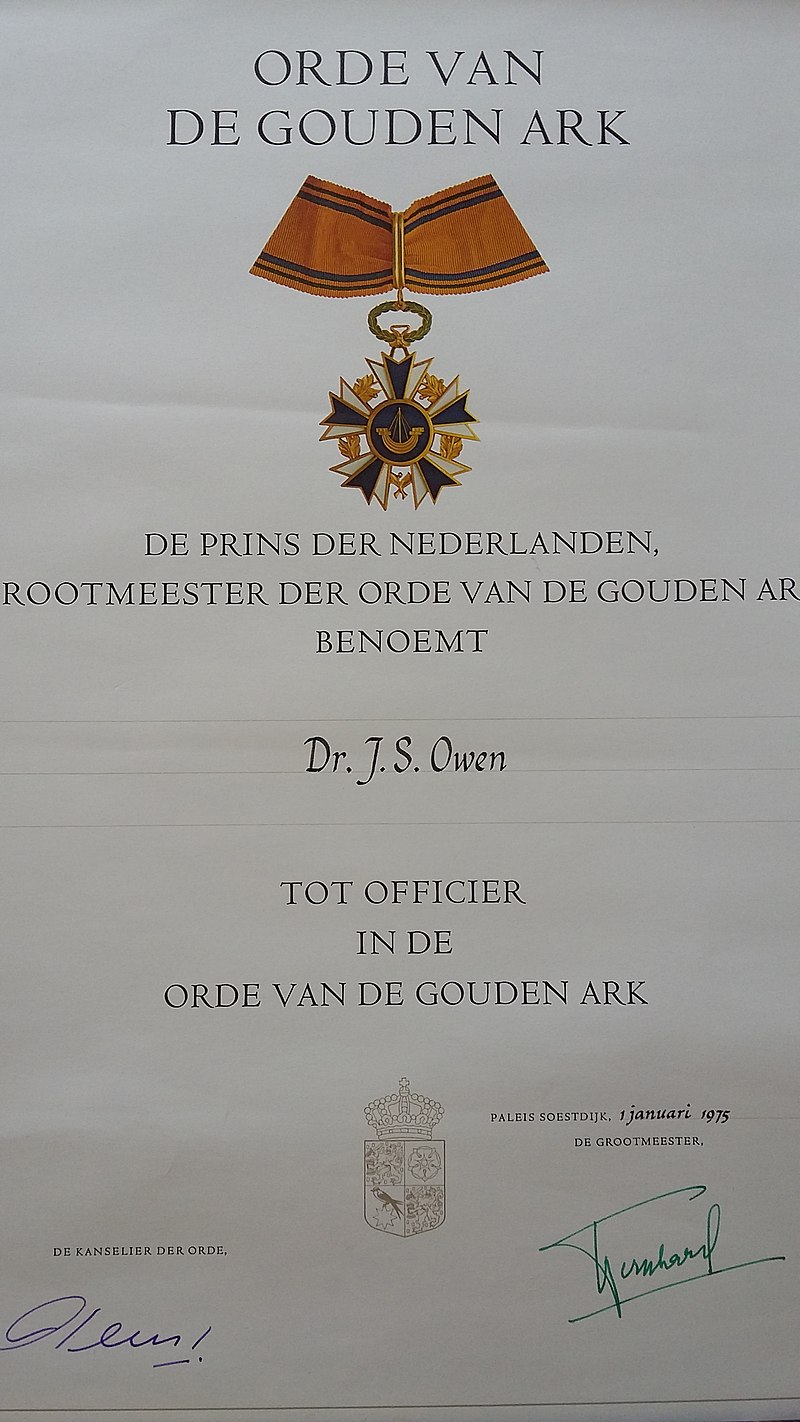John Owen
Pioneer of early conservation initiatives in Tanzania
John Owen
Owen, John . . . . Director of National Parks (at the time the colonial administration was relinquishing its control to the independant government of Tanzania). Described as avuncular, soft-spoken, and highly energetic, he was an orchestrator possessed with a vision for the Serengeti.... He raised money and amassed the equipment…Lisa Lindblad and Sven-Olof, The Serengeti; Land of Endless Space
John Simpson Owen was born on 31 December 1912, in Taro, in the foothills of the Ruwenzori Mountains of Uganda. The eldest of 3 sons, his parents Walter Edwin Owen and Lucy Olive Walton were missionaries with the Church Missionary Society.
He attended Christs Hospital School in Sussex (1922–1932). He attended Brasenose College, Oxford University (1932–1935), where he was awarded a Hulme Exhibition in natural science. He was awarded a B.A. (in Chemistry) on 17 October 1935 and an M.A. on 29 July 1972. He also completed a diploma in Anthropology.
Owen joined the Sudan Political Service in 1936, remaining until independence at which time he was Deputy Governor. He founded the Nimule National Park to protect the local white rhinoceros which he believed to be under threat. In 1953 he moved to Khartoum part of the team facilitating transition to independence of the Sudan.
He was appointed director of Tanganyika National Parks in 1960. In 1961 Tanganyika gained its independence and in 1963 became the country of Tanzania. He remained in post through to 1972. Owen presented a paper "Awakening Public Opinion To The Value Of The Tanganyika National Parks" at the Conference on the Conservation of Nature and Natural Resources in Modern African States (known as the Arusha Conference) in September 1961. In the paper he identified 5 themes which formed the basis of his vision for the value of the parks to the country. As Director of the Tanzania National Parks at this time he was responsible for the establishment and management a network of nine National Parks across Tanzania (including the Serengeti, Arusha and Gombe).
His involvement is recognised by Bernard Grzimek in his book Rhinos Belong to Everybody, where he is included in the foreword for his efforts to create the park system.
Amongst his most lasting achievements was transforming a small laboratory into the world-renowned Serengeti Scientific Research Institute. The Institute attracted many scientists to work there or to visit, including the Nobel-prize winner Niko Tinbergen and his students. In 1966 George Schaller came to study the lions, resulting in his book Serengeti Lion: A Study of Predator–Prey Relations. The dedication at the front of his book Serengeti a Kingdom of Predators was "To John S. Owen whose vision and initiative have helped to create in Tanzania some of the world's finest national parks". Hans Kruuk came to study the hyena, Harvey Croze joined in the late 1960s to study the impact of the elephants on the woodlands and Michael Norton-Griffiths studied the Serengeti ecology.
Field researchers were also based in other parks; Iain Douglas Hamilton studied the elephants in the rift valley Manyara National Park and Jane Goodall studied the chimpanzees in the Gombe Stream which moved under the National Park umbrella in 1968. His involvement in the parks is described in Peter Mattherson's The Tree where Man was Born.
By 1970, when John Owen had achieved virtually all of his aims, he felt his continued presence to be no longer beneficial for Parks. In a effort to secure greater political stability for the organisation he had done so much to build, he surrendered his post to a citizen of the country and remained in the background for another year to help in any way he could. John finally returned to England in 1971, leaving behind a sense of irreplaceable loss among those who valued his remarkable achievements and admired his qualities.Kay Turner, Serengeti Home
In 1973 Owen left Africa for the Woodrow Wilson International for Scholars in Washington, the think tank on global ecology.
After his retirement to Tunbridge Wells in the UK he fought and won several quixotic campaigns against planning authorities including preserving the medieval forest of High Wood near Tunbridge Wells from development. He was a fighter.
Tall, blue-eyed, vigorous and determined, he [John Owen] is a fitting son to one of Kenya's best-known and most controversial earlier figures, the Rev. Walter Owen, Archdeacon of Nyanza from 1918 to 1944, who belonged to the old school of fighting missionaries - fighting for the right as he saw it, a Christian who pulled no punches and was know to those whom he had punched as the Archdemon. Elspeth Huxley, Forks and Hope
AWARDS
In 1955 Owen was awarded the OBE for his campaigning work on pensions for ex-colonial officers. In 1971 he was made an Honorary Doctor of Science at Oxford University for his contribution to conservation, and in the same year, he was awarded the World Wildlife Fund Gold Medal. In 1975 he was awarded the Order of the Golden Arc by Prince Bernhard of the Netherlands, the inaugural president of the World Wildlife Fund.
(Courtesey: Wikipedia)
ARTICLES OF INTEREST
New York Times - Keeping The 'African Experience' African 1971 (PDF)
Go back to: Pioneers & Early conservationists
